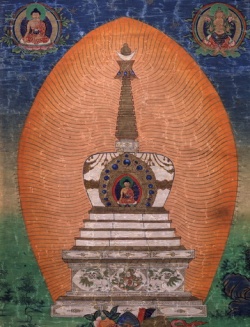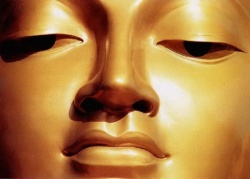Dungtso Repa ''The Earlier''
Dungtso Repa "The Earlier" (dung mtsho ras pa snga pa) was born in the thirteenth century in Yakar Ngonpo (g.yag mkhar sngon po) the Yarlung Valley. He was the middle son of Jungne O ('jung gnas 'od) and Kyedren Bum (khye 'dren 'bum), who gave him the name Sherab Gyatso (shes rab rgya mtsho). He was considered an incarnation of Nyang Tingzin Zangpo (myang ting 'dzin bzang po, 8th cent.) as well as of Kyepo Yeshe Dorje (skye po ye shes rdo rje, 12th cent.), a disciple of Gampopa Sonam Rinchen (sgam po pa bsod nams rin chen, 1079-1153).
In his youth Dungtso Repa stayed at the Densa Til (gdan sa mthil) monastery, the seat of Pakmodrupa's (phag mo gru pa) disciples. There he took novice ordination with a lama named Chennga Sertokpa (spyan snga gser thog pa, 1250-1310) and was giving the name Sherab Gyeltsen (shes rab rgyal mtshan). He took teachings from a number of Kagyu lamas in the area, including an unnamed Drukpa Kagyu lama in Yarlung, and Sanggye Lhagom (sangs rgyas lha sgom, 12th c.).
At Kharak Lhatso (kha rag lha mtsho) he received teachings from Trulzhik Khampa ('khrul zhig khams pa), who sent him to Bayul Yumtsho (ba yul g.yu mtsho), a high mountain lake in Dakpo (dags po). There he found a small meditation hut and settled in, and soon experienced terrifying visions. From beneath the floorboard of the hut he extracted a treasure inventory (gter kyi kha byang) that listed treasures concealed by Gampopa. According to the inventory he was to reveal the treasure in the year 1315.
With a clear mission, Dungtso Repa set out for Daklha Gampo (dwags lha sgam po), where he took final ordination with a lama named Dorje Lowa (rdo rje blo ba), receiving the name Rinchen Zangpo (rin chen bzang po). With an attendant, Dungtso Repa climbed the valley wall to a small frozen lake. There he spotted an image of the arhat Nakula. Fearing the treasure protector, he retrieved the image using a juniper log, and quickly performed propitiation rites to the deity. He then saw a stone casket under the ice, also with an image of Nakula inside. Inside the statue were treasure scrolls bound with leather and silk, as well as a number of books. Memorizing the text on the scrolls he returned them to the inside of the image, which he concealed in a crack in a cliff face. He brought the rest of the contents of the casket to Daklha Gampo, but left the monastery several days later.
Fearing that thieves might take his treasure, Dungtso Repa went to Mt. Tsari (tsa ri), staying at Kala Dungtso (kA la dung mtsho) for a year, and attracting some eight hundred disciples, mostly cotton-clad hermits in the tradition of Milarepa. One, Drogon Rinchendze ('gro mgon rin chen mdzes), from Tselpa Chukpo (mtshal pa phyug po) monastery, apparently knew of the treasures Dungtso Repa had in his possession, and received the entire transmission from him.
Dungtso Repa was also active in Drangmo Dzachu Darmo (grang mo'i rdza chu dar mo) and Nyel (gnyal), where he erected a temple dedicated to Gampopa.
The treasure Dungtso Repa had extracted was eventually codified as the Wish Granting Instruction on Mind (sems khrid yid bzhin nor bu), which came to be trasmitted primarily through the Zurmang Nyengyu tradition (zur mang snyan brgyud). His lineage holders included Trulzhik Nauwa ('khrul zhig sna'u ba), Tsari Repa (tsa ri ras pa), Jema Repa (bye ma ras pa), Domtsang Repa (dom tshang ras pa), Drolungpa (sgrod lung pa), and Tagtsang Repa (stag tshang ras pa).
Sources
Grags pa 'byung gnas and Rgyal ba blo bzang mkhas grub. 1992. Gangs can mkhas grub rim byon ming mdzod. Lanzhou: Kan su'u mi rigs dpe skrun khang, p. 825.
Roerich, George, trans. 1996. The Blue Annals. 2nd ed. Delhi: Motilal Banarsidas, pp. 717-720.
Gu ru bkra shis. 1990. Gu bkra'i chos ’byung. Beijing: Krung go’i bod kyi shes rig dpe skrun khang, p. 482
Bradburn, Leslie, ed. 1995. Masters of the Nyingma Lineage. Cazadero: Dharma Publications, 1995, pp. 137-138.
Jakob Leschly August 2007

